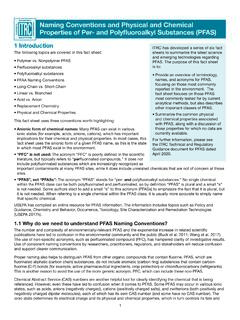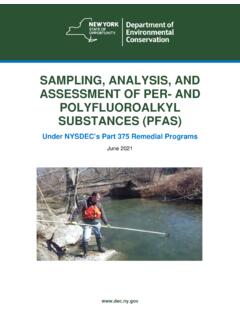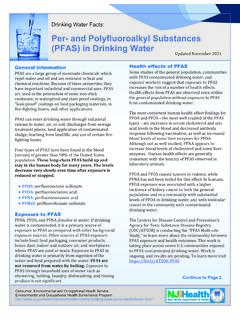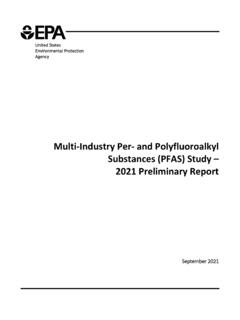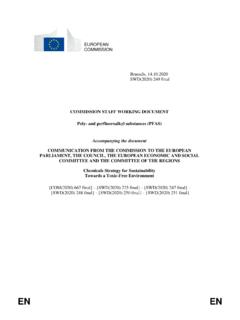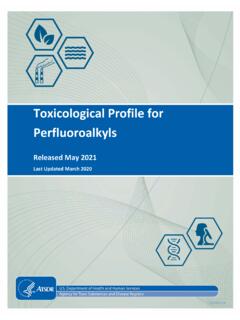Transcription of History and Use of Per- and Polyfluoroalkyl Substances (PFAS) …
1 History and Use of Per- and Polyfluoroalkyl Substances (PFAS). 1 Introduction ITRC has developed a series of fact The unique physical and chemical properties of per- and Polyfluoroalkyl sheets to summarize the latest science Substances (PFAS) impart oil and water repellency, temperature resistance, and emerging technologies regarding and friction reduction to a wide range of products used by consumers PFAS. The purpose of this fact sheet and industry. For example, PFAS, have been used in coatings for textiles, is to: paper products, and cookware and to formulate some firefighting foams, provide an overview of the discovery and have a range of applications in the aerospace, photographic imaging, and development of PFAS and the semiconductor, automotive, construction, electronics, and aviation subsequent detection of PFAS in the industries (KEMI 2015; USEPA 2017b). USEPA has compiled a web-based environment resource for PFAS information. The information includes topics such as Policy and Guidance, Chemistry and Behavior, Occurrence, Toxicology, Site describe emerging concerns of Characterization and Remediation Technologies (USEPA 2017h).
2 Potential adverse human health effects, and efforts to reduce use or The scientific community is rapidly recognizing and evolving its replace with alternate formulations, or understanding of the environmental and health impacts associated with both the release of PFAS. Certain PFAS, most notably some of the perfluoroalkyl identify the major sources of PFAS. acids (PFAAs), such as perfluorooctanoate (PFOA) and perfluorooctane in the environment, as well as other sulfonate (PFOS), are mobile, persistent, and bioaccumulative, and are not sources of PFAS to the environment known to degrade in the environment (USEPA 2003b; ATSDR 2015; NTP. that may be of interest 2016; Concawe 2016). For further information, please see Understanding the manufacturing History of PFAS, as well as past and the ITRC Technical and Regulatory current uses, allows for the identification of potential environmental sources Guidance Document for PFAS dated of PFAS, possible release mechanisms, and associated pathway-receptor April 2020.
3 Relationships. 2 Discovery and Manufacturing History PFAS are a complex family of manmade fluorinated organic chemicals (Wang et al. 2017) that have been produced since the mid-20th century. It has been estimated that the PFAS family may include approximately 5,000 to 10,000 chemicals (USEPA 2018i), with a recent inventory identifying more than 4,700 PFAS that could have been, or may be, on the global market (OECD 2018), and the uses of each of these PFAS may not be known (KEMI 2015a). Table 2-1 provides a general timeline of initial synthesis and commercial production of some of the more well-known PFAS, along with some of the more frequently associated products. PFAS are produced using several different processes. Two major processes have been used to manufacture fluorosurfactants (includes PFAAs) and side-chain fluorinated polymers: electrochemical fluorination (ECF) and telomerization (KEMI 2015). ECF was licensed by 3M in the 1940s (Banks, Smart, and Tatlow 1994).
4 3M has ceased using ECF to make certain long-chain PFAS but continues to use ECF to manufacture other, shorter chain PFAS (Buck et al. 2011). ECF produces a mixture of even- and odd- numbered carbon chain lengths of approximately 70% linear and 30% branched Substances (Concawe 2016). Fluorotelomerization was developed in the 1970s (Benskin 2011), and yields mainly even numbered, straight carbon chain isomers (Kissa 2001; Parsons et al. 2008). 1. History and Use of Per- and Polyfluoroalkyl Substances (PFAS) continued Table 2-1. Discovery and manufacturing History of select PFAS. PFAS1 Development Time Period 1930s 1940s 1950s 1960s 1970s 1980s 1990s 2000s PTFE Invented Non-Stick Waterproof Coatings Fabrics PFOS Initial Stain & Firefighting Reduction Production water foam of PFOS, PFOA, Resistant PFNA (and other Products select PFAS2). PFOA Initial Protective Production Coatings PFNA Initial Architectural Resins Production Fluoro- Initial Firefighting Foams Predominant form telomers Production of firefighting foam Dominant Electrochemical Fluorination (ECF) Fluoro- Process3 telomerization (shorter chain ECF).
5 Pre-Invention of Chemistry / Initial Chemical Synthesis / Commercial Products Introduced Production and Used Notes: 1. This table includes fluoropolymers, PFAAs, and fluorotelomers. PTFE (polytetrafluoroethylene) is a fluoropolymer. PFOS, PFOA, and PFNA (perfluorononanoic acid) are PFAAs. 2. Refer to Section 3. The dominant manufacturing process is shown in the table; note, however, that ECF and fluorotelomerization have both been, and continue to be, used for the production of select PFAS. Sources: Prevedouros et al. 2006; Concawe 2016; Chemours 2017; Gore-Tex 2017; US Naval Research Academy 2017. 3 health and Environmental Investigations Initial Studies Studies that found some PFAS in the blood of occupationally exposed workers in the 1970s and reported detections in the blood of the general human population in the 1990s (Buck et al. 2011) led to increased awareness of PFAAs in the environment, associated human exposure, and the potential for health effects. PFAAs (such as PFOS and PFOA) are found in the blood and serum of most people whether exposed in the workplace or not.
6 This is attributed to widespread use, ability to bind to blood proteins and long half-lives in humans (Kannan et al. 2004; Karrman et al. 2006; Olsen et al. 2003). Laboratory studies using animals and epidemiological studies of human populations show that exposure to some PFAS may be associated with a wide range of adverse human health effects (USEPA 2016b, c; ATSDR 2017). Although some PFAS have been manufactured for more than 50 years, PFAS were not widely documented in environmental samples until the early 2000s. Early detection at low reporting limits was hindered due to analytical capability challenges arising from the unique surface-active properties of PFAS (Giesy and Kannan 2001; 3M 2000). Many manuscripts have since been published showing widespread distribution of certain PFAS, such as PFAAs, in various matrices including sediments, surface and groundwater, wildlife, and human blood (whole, plasma, and serum). (Kannan et al. 2004; Yamashita et al. 2005; Higgins et al.)
7 2005; Rankin et al. 2016). Some PFAS (such as PFAAs) are found in many places throughout the globe, even in areas well beyond where they were initially used or manufactured (Houde et al. 2011). Emerging Awareness The awareness and emphasis on various PFAS have evolved. Early focus was on the longer-chain (see Section ), perfluoroalkyl acids (PFAAs). In 2016, USEPA issued a Lifetime health Advisory (LHA) for two of the most widely detected PFAAs, PFOA and PFOS. Set at 70 nanograms per liter (ng/L, equivalent to parts per trillion [ppt]), the LHA applies for each PFAA, as well as in combination, in drinking water (USEPA 2016d). 2. History and Use of Per- and Polyfluoroalkyl Substances (PFAS) continued Six additional PFAAs have recently gained attention after their inclusion in the USEPA Unregulated Contaminant Monitoring Rule (UCMR). The third round of monitoring, or UCMR3, was promulgated in 2012 for tracking chemicals suspected to be present in drinking water , but do not have health -based standards set by the Safe drinking water Act.
8 A. summary of the occurrence data is included in the Regulations, Guidance, and Advisories Fact Sheet. Many state regulatory agencies now request or require testing for an expanded list of long- and short-chain PFAAs, Figure 2-14. and some potential precursors to PFAAs, such as fluorotelomers. Other Polyfluoroalkyl Substances are also receiving increased attention, as illustrated in Figure 3-1. Initial Attention Common Analytes UCMR3. PFOS PFOA. PFHxS PFNA. Carboxylates Sulfonates PFBS PFHpA. Early Attention All PFAS. PFDS PFTeDA, PFTrDA, PFNS PFDoA, PFUnA, PFHpS PFDA, PFHxA, PFPeS PFPeA, PFBA. Fluorotelomers, Perfluoroethers, Perfluoropolyethers Recent Attention All other PFAS Increasing Attention Thematic and not proportional. Bottom of triangle indicates additional number of compounds;. not a greater quantity by mass, concentration, or frequency of detection. Figure 3-1. Emerging awareness and emphasis on PFAS occurrence in the environment (Source: J. Hale, Kleinfelder, used with permission).
9 Stockholm Convention on Persistent Organic Pollutants The Stockholm Convention on Persistent Organic Pollutants (POPs) is a United Nations treaty signed in 2001 aimed at reducing or eliminating the production, use, and release of key POPs. POPs are defined as synthetic, organic compounds that, to varying degrees, resist photolytic, biological, and chemical degradation (KEMI 2004 and 2005;. USEPA 2017k). In 2009, Annex B of the Stockholm Convention was amended to include PFOS, because it is persistent in the environment and is not known to degrade at any environmental condition. At this time, the has not ratified the amendment (KEMI 2017). According to the Stockholm Convention website, further amendments approved in 2019. included discontinuing several of the previously allowed ongoing uses of PFOS, as well as prohibiting and/or eliminating the production and use of PFOA and related compounds (with certain exemptions). Further, the POPs Review Committee recommended to list PFHxS (perfluorohexane sulfonic acid) without specific exemptions.
10 Phase-out of Long-Chain PFAS. Due to industry and regulatory concerns about the potential health and environmental impacts, there has been a reduction in the manufacture and use of long-chain PFAAs. Long-chain PFAAs include perfluorinated carboxylates (PFCAs) with eight or more fully fluorinated carbons (for example, PFOA) and perfluorinated sulfonates (PFSAs) with six or more fully fluorinated carbons (for example, PFHxS and PFOS), their salts, and precursor compounds capable of 3. History and Use of Per- and Polyfluoroalkyl Substances (PFAS) continued forming long-chain PFAAs (USEPA 2009a; Buck et al. 2011; OECD 2013; Wang et al. 2015). In May 2000, 3M, the principal worldwide manufacturer and sole manufacturer of PFOS, announced a voluntary phase-out of perfluorooctanyl chemistries, which included PFOS, PFHxS, PFOA, and related precursors. 3M reportedly completed most of the phase-out by the end of 2002, with the remaining phase-out completed by 2008 (USEPA 2003b.)


